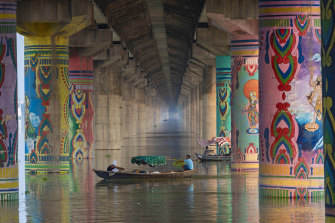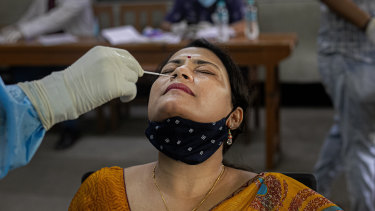‘There is no light at the end of the tunnel’: Indian virus cases surge
New Delhi: India’s coronavirus cases crossed 4 million on Saturday, leading the world in new infections and deepening the misery in the country's vast hinterlands where surges have crippled the underfunded healthcare system.
Initially, the virus ravaged sprawling and densely populated cities. It has since stretched to almost every state, spreading through villages and smaller towns.
Heavy monsoon rains have raised the water level of the Ganges River in Prayagraj, India. The country is in the midst of a coronavirus surge that has infected more than 4 million people.Credit:AP
With a population of nearly 1.4 billion people, the massive caseload isn’t surprising experts. The country’s delayed response to the virus forced the government to implement a harsh lockdown in late March. For more than two months, the economy remained shuttered, buying time for health workers to prepare for the worst.
But with the cost of the restrictions also rising, authorities reopened businesses and everyday activities.
Most of the cases are in western Maharashtra and the four southern states of Tamil Nadu, Andhra Pradesh, Telangana and Karnataka. But new surges are popping up elsewhere.
The 86,432 cases added in the 24 hours to Saturday pushed the total to 4,023,179. Globally, Brazil had confirmed 4,091,801 infections while the US had 6,200,186, according to Johns Hopkins University.
The Indian Health Ministry on Saturday also reported 1089 deaths for a total of 69,561.
Even as testing has increased to more than 1 million a day, a growing reliance on screening for antigens or viral proteins is creating more problems. These tests are cheaper and yield faster results but aren’t as accurate. The danger is that the tests may falsely clear many who are infected with COVID-19.
In Uttar Pradesh, the most populous state, the situation is already grim. With a total 253,175 cases and 3762 deaths, it is staring at an inevitable surge and with the shortage of hospital beds and other health infrastructure.
Sujata Prakash, a nurse in the state capital Lucknow, has recently tested positive for the new coronavirus. But the hospital ward where she worked diligently refused her admission because there was no empty bed. She waited for more than 24 hours outside the surgical ward, sitting on patients’ chairs, before she was allotted one.
“The government can shower flower petals on the hospitals in the name of corona warriors, but can’t the administration provide a bed when the same warrior needs one,” said Prakash’s husband, Vivek Kumar.
Others haven’t been so lucky.
When journalist Amrit Mohan Dubey fell sick this week, his friends called the local administration for an ambulance. It arrived two hours late and by the time Dubey was taken to the hospital, he died.
“Had the ambulance reached in time, we could have saved Amrit,” said Zafar Irshad, a colleague.
An Indian health worker collects nasal swab samples of teachers to test for COVID-19 at a school before classes open in Gauhati, India, on Wednesday.Credit:AP
In rural Maharashtra, the worst-affected state, doctors said measures like wearing masks and washing hands had now largely been abandoned.
“There is a behavioural fatigue now setting in,” said Dr SP Kalantri, the director of a hospital in the village of Sevagram.
He said that the past few weeks had driven home the point that the virus had moved from India’s cities to its villages.
“The worst is yet to come,” said Kalantri. “There is no light at the end of the tunnel.”
AP
Sign up to our Coronavirus Update newsletter
Get our Coronavirus Update newsletter for the day’s crucial developments at a glance, the numbers you need to know and what our readers are saying. Sign up to The Sydney Morning Herald’s newsletter here and The Age’s here.
Most Viewed in World
Source: Read Full Article

